Coimbra
Coimbra (/koʊˈɪmbrə/, also US: /kuˈ-, ˈkwɪmbrə/,[1][2] UK: /ˈkɔɪmbrə/,[3] Portuguese: [kuˈĩbɾɐ] (![]()
Coimbra | |
|---|---|
_(cropped).jpg) _(cropped).jpg) _(cropped).jpg) _(cropped).jpg) Clockwise: View of Coimbra from the Mondego River; University of Coimbra; Coimbra waterfront; Santa Cruz Monastery; Coimbra baixa. | |
 Flag  Coat of arms | |
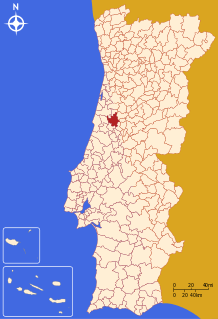 | |
| Coordinates: 40°12′40″N 8°25′45″W | |
| Country | |
| Region | Centro |
| Intermunic. comm. | Região de Coimbra |
| District | Coimbra |
| Parishes | 18 (list) |
| Government | |
| • President | Manuel Machado (PS) |
| Area | |
| • Total | 319.40 km2 (123.32 sq mi) |
| Highest elevation | 499 m (1,637 ft) |
| Lowest elevation | 9 m (30 ft) |
| Population (2011) | |
| • Total | 143,396 |
| • Density | 450/km2 (1,200/sq mi) |
| Time zone | UTC±00:00 (WET) |
| • Summer (DST) | UTC+01:00 (WEST) |
| Postal code | 3000 |
| Area code | 239 |
| Patron | Rainha Santa Isabel |
| Website | www |
Among the many archaeological structures dating back to the Roman era, when Coimbra was the settlement of Aeminium, are its well-preserved aqueduct and cryptoporticus. Similarly, buildings from the period when Coimbra was the capital of Portugal (from 1131 to 1255) still remain. During the late Middle Ages, with its decline as the political centre of the Kingdom of Portugal, Coimbra began to evolve into a major cultural centre. This was in large part helped by the establishment of the University of Coimbra in 1290, the oldest academic institution in the Portuguese-speaking world. Apart from attracting many European and international students, the university is visited by many tourists for its monuments and history. Its historical buildings were classified as a World Heritage site by UNESCO in 2013: "Coimbra offers an outstanding example of an integrated university city with a specific urban typology as well as its own ceremonial and cultural traditions that have been kept alive through the ages."[7]
History
Early history

The city, located on a hill by the Mondego River, was called Aeminium in Roman times. It fell under the influence, administratively, of the larger Roman villa of Conímbriga (in Condeixa-a-Nova), until the latter was sacked by the Sueves and Visigoths between 569 and 589 and abandoned.[8] It became the seat of a diocesis, replacing Conímbriga. Although Conimbriga had been administratively important, Aeminium affirmed its position by being situated at the confluence of the north–south traffic that connected the Roman Bracara Augusta (later Braga) and Olisipo (later Lisbon) with its waterway, which enabled connections with the interior and coast. The limestone table on which the settlement grew has a dominant position overlooking the Mondego, circled by fertile lands irrigated by its waters. Vestiges of this early history include the cryptoporticus of the former Roman forum (now part of the Museu Nacional de Machado de Castro). The move of the settlement and bishopric of Conimbriga to Aeminium resulted in the name change to Conimbriga, evolving later to Colimbria.[8]

During the Visigothic era (around the eighth century), the County of Coimbra was created by King Wittiza and it was a sub-county of his dominion, established as a fief for his son Prince Ardabast (or Sisebuto), with its seat in Emínio (the Visigothic name for Coimbra), which persisted until the Muslim invasion from the south.
The first Muslim campaigns that occupied the Iberian peninsula occurred between 711 and 715, with Coimbra capitulating to Musa bin Nusair in 714. Although it was not a large settlement, Qulumriyah (Arabic: قُلُمْرِيَة), in the context of Al-Andalus, was the largest agglomerated centre along the northern Tagus valley, and its principal city boasted a walled enclosure of 10 hectares, supporting between 3000 and 5000 inhabitants. Remnants of this period include the beginnings of the Almedina, Arrabalde and the fortified palace used by the city's governor (which was later converted into the Royal Palace by the early Portuguese monarchs). The Christian Reconquista forced the Banu Dānis and the other Muslims to abandon the region temporarily. Successively the Moors retook the castle in 987–1064 and again in 1116, capturing two castles constructed to protect the territory: in Miranda da Beira (where the garrison was slaughtered) and in Santa Eulália (where the governor rendered his forces rather than facing a similar massacre).[8]
Middle Ages
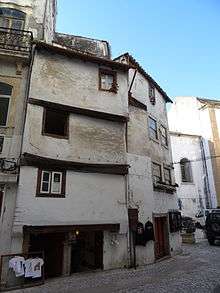
The reconquest of the territory was attained in 1064 by King Ferdinand I of León and Castile, who appointed Dom Sisnando Davides to reorganize the economy and administer the lands encircling the city. The County of Portucale and the County of Coimbra were later integrated into one dominion under the stewardship of Henry of Burgundy by Alfonso VI of León and Castile in 1096, when Henry married Alfonso's illegitimate daughter Theresa. Henry expanded the frontiers of the County, confronting the Moorish forces, and upon his death in 1112, Theresa, Countess of Portucale and Coimbra, unified her possessions. Their son, Afonso Henriques, who took up residence in the ancient seat of the Christian County of Coimbra, sent expeditions to the south and west, consolidating a network of castles that included Leiria, Soure, Rabaçal, Alvorge and Ansião.[8]

During the 12th century, Afonso Henriques administered an area of fertile lands with river access and protected by a fortified city, whose population exceeded 6000 inhabitants, including magnates, knights and high clergy. The young Infante encouraged the construction of his seat, funding the Santa Cruz Monastery (the most important Portuguese monastic institution at the time, founded in 1131 by Theotonius), promoted the construction of the Old Cathedral, reconstructed the original Roman bridge in 1132, and repaired and renovated fountains, kilns, roads and stone pavements, as well as the walls of the old city. In order to confirm and reinforce the power of the concelho (municipality) he conceded a formal foral (charter) in 1179.
Already in the Middle Ages, Coimbra was divided into an upper city (Cidade Alta or Almedina), where the aristocracy and the clergy lived, and the merchant, artisan and labour centres in the lower city (Arrabalde or Cidade Baixa) by the Mondego River, in addition to the old and new Jewish quarters. The city was encircled by a fortified wall, of which some remnants are still visible like the Almedina Gate (Porta da Almedina).

Meanwhile, on the periphery, the municipality began to grow in various agglomerations, notably around the monasteries and convents that developed in Celas, Santa Clara, Santo António dos Olivais. The most important work in Gothic style in the city is the Monastery of Santa Clara-a-Velha, founded on the left side of the river Mondego by Queen Elizabeth of Portugal in the first half of the 14th century. It stood too close to the river, and frequent floods forced the nuns to abandon it in the 17th century, when the Monastery of Santa Clara-a-Nova was built uphill. The Queen's magnificent Gothic tomb was also transferred to the new convent. The ruins of the old convent were excavated in the 2000s, and can be seen today on the left bank of the river.
Renaissance

In the 15th and 16th centuries, during the Age of Discovery, Coimbra was again one of the main artistic centres of Portugal thanks to both local and royal patronage. Coimbra bishops, religious orders and King Manuel I supported artists like Diogo Pires (father and son), Marcos Pires, João de Castilho, Diogo de Castilho and the Frenchmen, João de Ruão and Nicholas of Chanterene, among others, who left important Manueline and Renaissance works in the town. Dating from this period are the remodelling (in Manueline style) of the Santa Cruz Monastery, including the tombs of Kings Afonso Henriques and Sancho I, the Renaissance Manga Fountain, and the altarpieces and triumphal portal of the Old Cathedral, among other works.
The University of Coimbra, was founded as a Studium Generale in Lisbon in 1290 by King Dinis I. The University was relocated to Coimbra in 1308, but in 1338 King D. Afonso IV returned the University to Lisbon. The University was definitively transferred to the premises of Coimbra Royal Palace in 1537 by King John III, and expanded by 1544 to occupy the Coimbra Royal Palace. Since then, city life has revolved around the state-run university. For many decades, several colleges (colégios) established by the religious orders provided an alternative to the official institution, but were gradually discontinued with the secularization of education in Portugal. Built in the 18th century, the Joanina Library (Biblioteca Joanina), a Baroque library, is another notable landmark of the ancient university. The Baroque University Tower (Torre da Universidade), from the school of the German architect Ludovice and built between 1728 and 1733, is the city's library.
Baroque and modern

In 1772, the Marquis of Pombal, prime minister of King José I, undertook a major reform of the university, where the study of the sciences assumed vast importance. The collections of scientific instruments and material acquired then are now gathered in the Science Museum of the University of Coimbra, and constitute one of the most important historical science collections in Europe. However, his desire to modernise the university resulted in the complete demolition of Coimbra's medieval city walls and castle. Very little, of which remains today.[9]
The first half of the 19th century was a difficult period for Coimbra, being invaded by French troops under the command of Andoche Junot and André Masséna during the Peninsular War. A force of 4,000 Portuguese militia led by Nicholas Trant dealt Masséna a heavy blow when it recaptured the city on 6 October 1810. In March 1811, the militia successfully held the place against the retreating French army. The city recovered in the second half of the 19th century with infrastructure improvements like the telegraph, gas light, the railway system, a railway bridge over the Mondego River and the renovation of the Portela bridge, in addition to the broadening of roads and expansion of the city into the Quinta de Santa Cruz.

By 1854, with the expulsion of the religious orders and municipal reforms, the need to reorganize the municipality of Coimbra forced some changes in the existing structure of the administrative divisions. Consequently, documents were sent (on 20 January 1854) to the Ministries of Ecclesiastical Affairs (Portuguese: Ministério dos Negócios Eclesiásticos) and Justice (Portuguese: Ministério de Justiça) urging the identification by the Civil Governor and Archbishop of Coimbra (Manuel Bento Rodrigues) of the number of civil parishes to preserve, their limits, the political organs to be retained, a local census and other statistics to justify the demarcation of the territory.[10] A commission of five members, which included João Maria Baptista Callixto, António dos Santos Pereira Jardim, Roque Joaquim Fernandes Thomás, João Correia Ayres de Campos and António Egypcio Quaresma Lopes de Carvalho e Vasconcelos, was appointed to produce a plan to reduce, suppress, demarcate and establish civil parishes in the city of Coimbra and its suburbs.[10]
Republic
On 1 January 1911, electric tramways were inaugurated to connect the old quarter with its expanding periphery, which included the residential areas of Celas, Olivais, Penedo da Saudade and Calhabé, all located in the civil parish of Santo António dos Olivais. This was only the initiation of the municipality growth. Civil construction projects throughout the region marked the economic activity of the territory, with new areas such as Montes Claros, Arregaça, Cumeada and Calhabé growing in the shadow of the city. Even projects that had been planned at the end of the 19th century gained new initiative, including the expansion of the Santa Cruz neighbourhood (bairro), the demolition of the residential area of the Alta de Coimbra (1940–50) to expand the University, and construction or expansion of the bairros of Celas, Sete Fontes and Marechal Carmona (now the bairro of Norton de Matos).
Geography
.jpg)
One of the nation's most important crossroads, Coimbra was historically at a junction between Braga and Lisbon, and its river access (the Mondego flows through the municipality) provided a route between the interior communities and the coastal towns (including the seaside city of Figueira da Foz, 40 km (25 mi) west of Coimbra). The historic city of Coimbra is located centrally within the municipality, connected to Lisbon (197 km (122 mi)) and Porto (116 km (72 mi)) by the IC2, IP3 and A1 motorways.[11]
The municipality is circled by several of its neighbouring municipalities in the Região de Coimbra, which include Penacova (in the northeast), Vila Nova de Poiares (to the east), Miranda do Corvo (to the southeast), Condeixa-a-Nova (to the south and southwest), Montemor-o-Velho (to the west), Cantanhede (to the northwest) and Mealhada (in the north and northeast). Just outside the municipality, there are also several picturesque mountain towns such as Lousã and Penacova, while spa towns and villages, such as Luso, Buçaco and Curia are commonplace.
Although it ceased in the 13th century to serve as the capital of Portugal, Coimbra retains considerable importance as the centre of the former Beira province, now designated the Centro region. It is considered alongside Braga one of the two most important regional centres in Portugal outside the Lisbon and Portos metropoles, the centre for the whole middle region of the country. With a dense urban grid, the municipality is known primarily for the city of Coimbra, itself famous for its monuments, churches, libraries, museums, parks, nightlife, healthcare and shopping facilities. Above all, its cultural life, oriented around the University of Coimbra, has historically attracted the nation's notable writers, artists, academics and aristocracy, securing its reputation as the Lusa-Atenas (Lusitanian Athens).
Ecoregions/protected areas
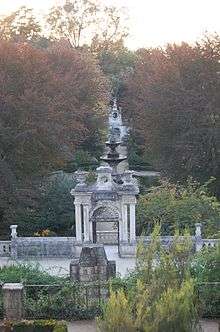
The western edge of Coimbra is covered by the Reserva Natural do Paul de Arzila (Arzila Swamp Natural Reserve), which is designated both as a Special Protection Zone (Portuguese: Zona de Protecção Especial) and Special Conservation Zone (Portuguese: Zona Especial de Conservação), coincident with the civil parish of Arzila (sometimes referred to as the Paul de Arzila or marsh of Arzila).[12] It is a wetland that has sheltered migratory birds, and supports other animal and plant species; this has included predominantly avian species, such as the: Eurasian reed warbler (Acrocephalus scirpaceus), sedge warbler (Acrocephalus schoenobaenus), melodious warbler (Hippolais polyglotta), willow warbler (Phylloscopus trochilus), little bittern (Ixobrychus minutus), great reed warbler (Acrocephalus arundinaceus), and the Savi's warbler (Locustella luscinioides).[12] The 482 hectare area, under threat from industrial, residential and agricultural pollution, expansion of aquatic plants and eutrophication, has forced the governmental reorganization of land use in order to promote models of sustainability, and rural use that does not affect the migratory and aquatic bird populations.[12]
The municipal government has also promoted the installation and maintenance of various parks, playgrounds, gardens and forests, including the development of the Botanical Garden of the University of Coimbra (considered the fifth oldest in the world), the Mata Nacional do Choupal, the Mata Nacional de Vale de Canas, Jardim da Sereia (also known as Santa Cruz Garden), Penedo da Saudade, Parque Manuel Braga, Parque Verde do Mondego, Choupalinho, and the 19th century Quinta das Lágrimas estate and gardens.
Complementing these natural spaces are the riverside parks and bathing areas that line the Mondego, including the river beaches of Palheiros do Zorro, in the parish of Torres do Mondego.
The city is on the Portuguese Way of the Road of St James (Caminho de Santiago).
Climate
Coimbra has a warm-summer Mediterranean climate (Köppen: Csb) in a transition to a hot-summer (Csa) version of the interior of Central Portugal.[13] In winter, temperatures range between 15 °C (59 °F) at day and 5 °C (41 °F) at night in the coldest month and some times could drop below 0 °C (32 °F), while summer temperatures range between 29 °C (84 °F) at day and 16 °C (61 °F) at night and can reach 40 °C (104 °F) or more. The highest and lowest temperatures recorded in Coimbra are −7.8 °C (18.0 °F) and 42.5 °C (108.5 °F) in 1941 and 1943. The average of days in a year with minimum temperature less than 0 °C (32 °F) is 10.5 and with maximum temperature above 30 °C (86 °F) is 32.2.[14]
| Climate data for Coimbra (Mesura), elevation: 35 m or 115 ft, 1981-2010 normals and extremes | |||||||||||||
|---|---|---|---|---|---|---|---|---|---|---|---|---|---|
| Month | Jan | Feb | Mar | Apr | May | Jun | Jul | Aug | Sep | Oct | Nov | Dec | Year |
| Record high °C (°F) | 23.5 (74.3) |
25.5 (77.9) |
30.2 (86.4) |
33.0 (91.4) |
37.5 (99.5) |
41.6 (106.9) |
40.2 (104.4) |
40.5 (104.9) |
40.0 (104.0) |
34.6 (94.3) |
27.6 (81.7) |
25.2 (77.4) |
41.6 (106.9) |
| Average high °C (°F) | 14.8 (58.6) |
16.2 (61.2) |
18.9 (66.0) |
19.9 (67.8) |
22.4 (72.3) |
26.2 (79.2) |
28.4 (83.1) |
28.7 (83.7) |
27.3 (81.1) |
22.7 (72.9) |
18.0 (64.4) |
15.4 (59.7) |
21.6 (70.8) |
| Daily mean °C (°F) | 9.9 (49.8) |
11.0 (51.8) |
13.3 (55.9) |
14.5 (58.1) |
16.9 (62.4) |
20.3 (68.5) |
21.9 (71.4) |
21.9 (71.4) |
20.7 (69.3) |
17.2 (63.0) |
13.3 (55.9) |
11.0 (51.8) |
16.0 (60.8) |
| Average low °C (°F) | 5.0 (41.0) |
5.8 (42.4) |
7.6 (45.7) |
9.1 (48.4) |
11.4 (52.5) |
14.3 (57.7) |
15.6 (60.1) |
15.1 (59.2) |
14.1 (57.4) |
11.8 (53.2) |
8.6 (47.5) |
6.5 (43.7) |
10.4 (50.7) |
| Record low °C (°F) | −4.9 (23.2) |
−4.0 (24.8) |
−3.3 (26.1) |
−1.5 (29.3) |
2.0 (35.6) |
4.1 (39.4) |
6.8 (44.2) |
6.0 (42.8) |
2.0 (35.6) |
−2.6 (27.3) |
−3.1 (26.4) |
−2.8 (27.0) |
−4.9 (23.2) |
| Average precipitation mm (inches) | 112.2 (4.42) |
105.6 (4.16) |
65.5 (2.58) |
84.8 (3.34) |
79.5 (3.13) |
39.8 (1.57) |
12.8 (0.50) |
14.4 (0.57) |
51.7 (2.04) |
102.6 (4.04) |
109.4 (4.31) |
126.8 (4.99) |
905.1 (35.63) |
| Source: IPMA[15] | |||||||||||||
| Climate data for Coimbra, 1961-1990 normals and extremes | |||||||||||||
|---|---|---|---|---|---|---|---|---|---|---|---|---|---|
| Month | Jan | Feb | Mar | Apr | May | Jun | Jul | Aug | Sep | Oct | Nov | Dec | Year |
| Record high °C (°F) | 22.5 (72.5) |
24.6 (76.3) |
28.6 (83.5) |
29.2 (84.6) |
38.0 (100.4) |
42.3 (108.1) |
40.3 (104.5) |
42.3 (108.1) |
40.6 (105.1) |
33.8 (92.8) |
30.4 (86.7) |
24.4 (75.9) |
42.3 (108.1) |
| Average high °C (°F) | 14.2 (57.6) |
15.4 (59.7) |
17.7 (63.9) |
19.3 (66.7) |
22.0 (71.6) |
25.6 (78.1) |
28.4 (83.1) |
28.7 (83.7) |
27.2 (81.0) |
22.6 (72.7) |
17.5 (63.5) |
14.5 (58.1) |
21.1 (70.0) |
| Daily mean °C (°F) | 10.0 (50.0) |
11.0 (51.8) |
12.5 (54.5) |
14.0 (57.2) |
16.4 (61.5) |
19.6 (67.3) |
21.8 (71.2) |
21.8 (71.2) |
20.8 (69.4) |
17.4 (63.3) |
13.0 (55.4) |
10.4 (50.7) |
15.7 (60.3) |
| Average low °C (°F) | 5.7 (42.3) |
6.5 (43.7) |
7.3 (45.1) |
8.6 (47.5) |
10.8 (51.4) |
13.6 (56.5) |
15.3 (59.5) |
14.9 (58.8) |
14.3 (57.7) |
12.1 (53.8) |
8.5 (47.3) |
6.4 (43.5) |
10.3 (50.6) |
| Record low °C (°F) | −3.8 (25.2) |
−3.4 (25.9) |
−1.6 (29.1) |
0.4 (32.7) |
3.3 (37.9) |
5.6 (42.1) |
9.2 (48.6) |
8.2 (46.8) |
4.3 (39.7) |
1.2 (34.2) |
−0.8 (30.6) |
−2.9 (26.8) |
−3.8 (25.2) |
| Average precipitation mm (inches) | 138.0 (5.43) |
139.0 (5.47) |
88.0 (3.46) |
91.0 (3.58) |
78.0 (3.07) |
51.0 (2.01) |
15.0 (0.59) |
13.0 (0.51) |
47.0 (1.85) |
97.0 (3.82) |
128.0 (5.04) |
129.0 (5.08) |
1,014 (39.91) |
| Average precipitation days (≥ 1.0 mm) | 13.0 | 12.0 | 10.0 | 11.0 | 9.0 | 6.0 | 2.0 | 2.0 | 6.0 | 10.0 | 11.0 | 11.0 | 103 |
| Average relative humidity (%) | 79.0 | 77.0 | 72.0 | 73.0 | 71.0 | 70.0 | 68.0 | 67.0 | 69.0 | 73.0 | 77.0 | 78.0 | 72.8 |
| Mean monthly sunshine hours | 138.0 | 137.0 | 191.0 | 203.0 | 249.0 | 261.0 | 302.0 | 300.0 | 228.0 | 185.0 | 147.0 | 139.0 | 2,480 |
| Source: NOAA[16] | |||||||||||||
Human geography

Administratively, the municipality is divided into 18 civil parishes (freguesias):[17]
- Almalaguês
- Antuzede e Vil de Matos
- Assafarge e Antanhol
- Brasfemes
- Ceira
- Cernache
- Coimbra (Sé Nova, Santa Cruz, Almedina e São Bartolomeu)
- Eiras e São Paulo de Frades
- São João do Campo
- São Martinho da Árvore e Lamarosa
- São Martinho do Bispo e Ribeira de Frades
- São Silvestre
- Souselas e Botão
- Santa Clara e Castelo Viegas
- Santo António dos Olivais
- Taveiro, Ameal e Arzila
- Torres do Mondego
- Trouxemil e Torre de Vilela
|
|
As of 2001, the municipality of Coimbra had a population of 148,443 inhabitants (covering an area of 319.4 km2), reflecting a 6.8% increase relative to 1991 (139,052 residents), while the number of families increased 17.1% in the same period.[11] This was mainly concentrated in the parish of Sé Nova, while the remaining administrative divisions accounted for a range of 78.54 to 5069.2 inhabitants per kilometre square.[11] Seniors and youth (age 0 to 14 years) represent a minority of the population (16.5% and 31.1%); the 25 to 64 cohort accounts for 55% of the active population. While per 100 inhabitants, seniors actually comprise 21.6% of this population, the birth rate (9.3%) is superior the mortality rate in the communities of Coimbra, which is actually greater than other municipalities in the Baixo Mondego subregion.[11]
The municipality of Coimbra has a resident population of 157,510 inhabitants, and seasonal population of approximately 200,000 residents. Between 1864 and 2001, the municipal population tripled (following the trend in the rest of the country when the nation's population doubled), while between 1991 and 2001 its population increased 6.75% (Portugal's population increased 4.08% in the same period).[18] On average, over 43,000 people flow to Coimbra every day to study and work. About 460,000 inhabitants live in the Região de Coimbra, consisting of 19 municipalities comprising a territory of 4,336 square kilometres (1,674 sq mi).
Internally, the network and location of public service/sector institutions (such as police stations, fire stations, public finance and notary services) have been located within 5.2 to 6.6 km (3.2 to 4.1 miles) of the resident population, while most tertiary shops and retail capture between 43.4% and 100% of the market.[11] Mini-markets and corner shops cover 100% of the population; generally, the longest distance travelled between shops is 8.7 km (5.4 mi) (for pastry shops).[11] Restaurants are usually within 74.2% of the population, and refreshment shops (such as bars and snack bars) routinely cover 100% of the market.[11] Commerce and vestuary shops range from coverage of 43.4% (for glasses) to 91.4% (of clothing); the largest distance that resident population requires to travel is 10.2 km (6.3 mi) for electro-domestics and auto-mobile purchases.[11] Repair services, which cover the largest part of the civil parishes, and specifically auto repair shops, cover 97.1% of the market. Public transport covers 90.3% of the parishes, with 93.5% of the population; 61.3% have taxi services (capturing 78.8% of the population); public buses serve 67.7% of the parishes (or 85% of the population); while rail services affect 35.5% of the parishes (serving 29.7% of the market); while unequipped parishes, on average, lie within 4.8 km (3.0 mi) of such services.[11] Postal services are provided in 15 parishes (48.4%), corresponding to 77.9% of the population, while 98.6% receive home distribution. Similarly, public telephones have a 94.6% coverage of the population.[11]
Economy
The wealth of the city rests mostly on the University of Coimbra with about 20,000 students – the city has a total of 35,000 higher education students considering the other higher education institutions based there – but also in shopping, technology and health sciences industry, administrative offices, financial services, law firms and specialized medical care. The city has many private clinics, medical offices and two large independent state hospital centres: the H.U.C. – Hospitais da Universidade de Coimbra, which is a university hospital, and the C.H.C. – Centro Hospitalar de Coimbra, which includes a general hospital. Coimbra has also the regional branch of the national cancer hospital – the I.P.O. – Instituto Português de Oncologia, as well as a military hospital. The Instituto Nacional de Medicina Legal, the state-run forensic science institute of Portugal, is headquartered in Coimbra.
Notable companies based in the municipality of Coimbra include software companies Critical Software and Ciberbit which have their global headquarters in the city, mechanical and electronics engineering company Active Space Technologies, telemetry and Machine to Machine company ISA, Cimpor's cement factory in Souselas (CIMPOR Souselas), the pan-European service facility of Olympus Corporation, the pharmaceuticals companies Bluepharma and BASI, the iron foundry Fucoli-Somepal and several ceramics, food processing (Probar produces cold meat products and Dan Cake produces sponge cakes and swiss rolls), textiles, wine, civil and engineering construction, architecture, public works and housing construction firms. Handicraft industry is well represented by traditional tapestry and pottery manufacture, and the surroundings of the city have besides forestry, dynamic horticulture production, vineyards and livestock raising. The Instituto Pedro Nunes (Pedro Nunes Institute), a business incubator, dynamically hosts several start-ups which are usually dedicated to technology-related businesses and became independent spin-off companies headquartered across the whole region. There is a move by municipal authorities to bring in more innovation and high-technology businesses, through initiatives such as the Coimbra Innovation Park, with the objective of promoting innovation and companies that promote research and development (such as nanotechnology company Innovnano, a subsidiary of Companhia União Fabril).[19]
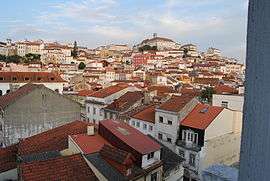
Coimbra has a fresh produce open-air market on every 7th and 23rd days of the month at Feira dos 7 e dos 23, and a large fresh produce market in downtown at Mercado D. Pedro V. The Baixa (downtown) of Coimbra has many coffeehouses and bakeries, and features several specialty shops selling all kind of products in typical old-fashioned architectural surroundings. Large commercial facilities with car park, include a medium-sized shopping center (CoimbraShopping); two larger shopping centers with hypermarket, restaurants, movie theaters and several shops with a selection of some of Portugal's and the world's most famous and stylish international brands include "Dolce Vita Coimbra" designed by the American planning and design firm, Suttle Mindlin and Forum Coimbra; and two retail parks found on the fringes of the city, offering an alternative to the busy city centre (Retail Park Mondego in Taveiro, and Coimbra Retail Park in Eiras). Dolce Vita Coimbra was the recipient of the 2006 MIPIM International Design Award; the 2006 ICSC International Design Award; and the 2006 ICSC European Design Award proving that Portugal and Coimbra offer both historical and thoroughly modern shopping experiences.
Transportation
The two banks of Mondego River at Coimbra, are linked by three main bridges: the Ponte do Açude, the Ponte de Santa Clara (which is the oldest) and Ponte Rainha Santa, also known as Ponte Europa. The Ponte Pedonal de Pedro e Inês is the most recently constructed bridge and the only footbridge in the city.
The city is internally connected by an extensive bus network, the SMTUC (Serviços Municipalizados de Transportes Urbanos de Coimbra, Coimbra Municipality Urban Transport Services) and the Coimbra trolleybus system (the only such system in Portugal). In the past, the city also had a tram network (some are now parked inside a transportation museum). Taxicabs are also available, and are recognizable as cream or black and green (black car with green rooftop) taxis. The city is a hub for interregional bus services for all the country and abroad. A light-rail metro system, Metro Mondego, was proposed however the project was abandoned at the height of Portuguese financial crisis.
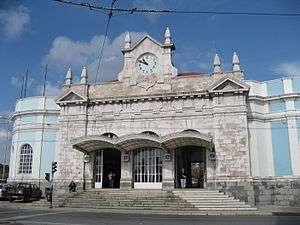
Coimbra has several rail stations. The principal station Coimbra-B is on the main line between Porto and Lisbon. In addition, the train-hotel Lusitania connects Coimbra and Madrid every night.[20]
From this station, a small spur runs to Coimbra-A, the main station in the city centre. A small regional rail line (Linha da Lousã) also ran from Coimbra Parque at the south edge of the city centre. From Coimbra-Parque was possible to travel to Miranda do Corvo, Lousã and Serpins, among others. The line was closed for upgrading as part of the Metro Mondego project and was never reopened when the Metro Mondego project was abandoned, but there is local pressure for the line to be reopened. It is also possible to travel by train between Coimbra and Figueira da Foz (Ramal de Alfarelos), and Coimbra, Guarda and Vilar Formoso (Linha da Beira Alta [international]).
Coimbra is served by the A1 motorway, which connects Lisbon to Porto.

A regional aerodrome is in Cernache (Aeródromo Municipal Bissaya Barreto) (CBP) [PCO], 7.5 kilometres (4.7 miles) southwest of the centre. With a 920 metres (3,018 feet) runway and Flight Information Service until sunset, this regional airport has all the fundamental facilities for private flights.
The average amount of time people spend commuting with public transit in Coimbra, for example to and from work, on a weekday is 35 min. 2.4% of public transit riders, ride for more than 2 hours every day. The average amount of time people wait at a stop or station for public transit is 12 min, and 16.8% of riders wait for over 20 min on average every day. The average distance people usually ride in a single trip with public transit is 2 km, and 0% travel for over 12 km in a single direction.[21]
Politics and government
Education
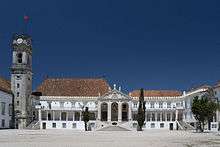
Coimbra has been called A cidade dos estudantes (The city of the students) or Lusa-Atenas (Lusitan-Athens), mainly because it is the site of the oldest and one of the largest universities in Portugal – the University of Coimbra, a public university whose origins can be traced back to the 13th century. Nowadays, it has students from 70 different nationalities; almost 10% of its students are foreigners, making it Portugal's most international university.
Coimbra is also the place where the oldest and biggest university students' union of Portugal was founded – the Associação Académica de Coimbra (Academic Association of Coimbra), established in 1887.
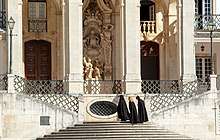
As well, there are some other schools and institutes of higher education in the city: the Instituto Politécnico de Coimbra, a public polytechnic institute; the Escola Superior de Enfermagem de Coimbra, a public nursing school; and some private higher education institutions such as the Instituto Superior Miguel Torga; the Instituto Superior Bissaya Barreto; the Escola Universitária Vasco da Gama and finally, the Escola Universitária das Artes de Coimbra, an art school.

A large number of higher education students from all of Portugal chose Coimbra's higher learning institutions to study, due to the wide availability of degrees offered in different fields, the student-friendly environment of the city, and the prestige of many of its learning institutions allied to the ancient tradition of Coimbra as the historical capital of higher studies in Portugal.
The city has also a large number of public and private basic and secondary schools, among these some of the best-ranked in the country, like Escola Secundária Infanta D. Maria (public), Escola Secundária José Falcão (public), "Escola EB2/3 Martim de Freitas" (public), Colégio Rainha Santa Isabel (private) and Colégio de São Teotónio (private), as well as several kindergartens and nurseries. There is also the Coimbra Hotel and Tourism School.
Architecture
Civic
- Forest/Moorish City of Antanhol (Portuguese: Cidade Da Mata do Antanhol), Antanhol
- Palace of Sub-Ripas (Portuguese: Paço de Sub-Ripas), Almedina
- São Sebastião Aqueduct/Garden Arches (Portuguese: Aqueducto de São Sebastião), Sé Nova
- University of Coimbra (Portuguese: Paços da Universidade de Coimbra), Sé Nova
Military
- Arch and Tower of the Almedina (Portuguese: Arco e Torre da Almedina), Almedina
Religious

- Cathedral (Nova) of Coimbra (Portuguese: Sé Nova de Coimbra), Sé Nova
- Cathedral (Velha) of Coimbra (Portuguese: Sé Velha de Coimbra), Almedina
- Chapel of the Treasurer (Portuguese: Capela do Tesoureiro), Sé Nova
- Church and Convent of São Marcos (Portuguese: Igreja e Convento de São Marcos), São Silvestres
- Church of Nossa Senhora da Graça (Portuguese: Igreja da Nossa Senhora da Graça), Santa Cruz
- Church of São Domingos (Portuguese: Igreja de São Domingos), Santa Cruz
- Church of São Salvador (Portuguese: Igreja de São Salvador), Sé Nova
- Church of São Tiago (Portuguese: Igreja de São Tiago), São Bartolomeu
- College of São Agostinho (Portuguese: Misericórdia de Coimbra/Colégio de São Agostinho), Sé Nova
- College of São Jerónimo (Portuguese: Colégio de São Jerónimo), Sé Nova
- College of São Tomas (Portuguese: Portas do Colégio de São Tomas), Sé Nova
- Cross of São Marcos (Portuguese: Cruzeiro de São Marcos), São Silvestres
- Episcopal Palace of Coimbra (Portuguese: Paço Episcopal de Coimbra), Sé Nova
- Manga Cloister (Portuguese: Claustro de Manga), Santa Cruz
- Monastery of Santa Clara-a-Nova (Portuguese: Mosteiro de Santa Clara-a-Nova), Santa Clara
- Monastery of Santa Clara-a-Velha (Portuguese: Mosteiro de Santa Clara-a-Velha), Santa Clara
- Monastery of Santa Cruz (Portuguese: Mosteiro de Santa Cruz), Santa Cruz
- Monastery of Santa Maria de Celas (Portuguese: Mosteiro de Santa Maria de Celas), Santo António de Olivais
- Monastery of São João das Donas (Portuguese: Mosteiro de São João das Donas), Santa Cruz
- (Former) Church of Carmo (Portuguese: Igreja do Carmo), Santa Cruz
- (Former) Portico of the Church of Santa Ana (Portuguese: Portais da Extinta Igreja de Santa Ana), Sé Nova
- Church of Saint Bartolomew, (Igreja São Bartolomeu)
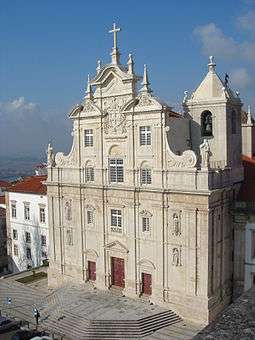
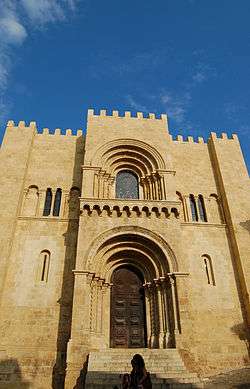
- São Tiago church
 Santa Cruz monastery
Santa Cruz monastery
Culture
Coimbra celebrates its municipal holiday on 4 July, in honour of Queen Elizabeth of Portugal (spouse of the King Denis); a religious and civic celebration that celebrated the life of the former Queen, that includes a fireworks display following the night-time march of the penitents.
Coimbra houses the following cultural institutions:
- Machado de Castro Museum, the second most important one in Portugal, housed in the former Episcopal Palace
- University of Coimbra General Library, Portugal's second biggest library, after the National Library in Lisbon
- The 18th-century Botanical Garden of the University of Coimbra
Coimbra fado
The Fado de Coimbra is a highly stylized genre of fado music originated in Coimbra. Among its most notable and historical adherents are guitarist Carlos Paredes and singer Zeca Afonso, while the Orfeon Académico de Coimbra (the oldest and most famous academic choir in Portugal) and the Associação Académica de Coimbra are important organizations that promote the culture and stylings of this subgenre of music. In addition, Coimbra has a contemporary music, boasting several live music venues, and some of the most popular clubs and music festivals in Portugal. Moreover, theConservatório de Música de Coimbra, musical departments of the Associação Académica de Coimbra and the music programmes of the Faculty of Letters are noted by many of top music schools in the country.
The Orfeon Académico de Coimbra is an autonomous organization of the students' union Associação Académica de Coimbra, established in 1880 by a law student of the University of Coimbra (UC), and the fado section of UC's Associação Académica de Coimbra itself, are important organizations in Coimbra fado promotion and preservation.
According to tradition, to applaud fado in Lisbon one would clap his hands, while in Coimbra cough as if clearing the throat is the typical way.
Student festivals
Coimbra is also known for its university students' festivals. Two are held every year. The first one, Latada or Festa das Latas ("The Tin Can Parade") is a homecoming parade that occurs at the beginning of the academic year, and is a welcome to the new university students (Caloiros).
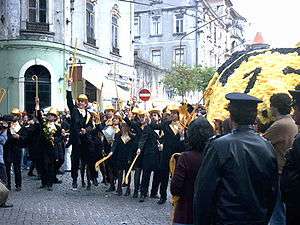
The Festa das Latas goes back to the 19th century when the Coimbra students felt the need to express their joy at finishing the school year in as loud a way as possible, using everything at their disposal that would make noise, namely tin cans. The highlight of this festival, which now takes place at the beginning of the academic year (November) is the special parade known as the Latada. After marching through the streets of the city the new students are "baptized" in the Mondego River thus entering into the Coimbra academic fraternity. The students from the penultimate year, normally the 3rd year's students, are awarded their Grelos (a small ribbon). The Grelo is a small, woollen ribbon with the color(s) of the student's faculty that is attached to a student's briefcase. Previous to this, at the morning the students must have visited the Dom Pedro V market where they must get a turnip to sustain the Caloiros during the day's festivities. Besides the tin cans they have tied to their legs, the new students wear all kinds of costumes made up according to the creativity and imagination of their godmothers or godfathers who are older students. They also carry placards with ironic criticisms alluding to certain teachers, the educational system, national events and leaders.
The second one, Queima das Fitas ("The Burning of the Ribbons"), takes place at the end of the second semester (usually in the beginning of May) and it is one of the biggest student parties in all Europe. It lasts for 8 days, one for each University of Coimbra's Faculty: Letras (Humanities), Direito (Law), Medicina (Medicine), Ciências e Tecnologia (Sciences and Technology), Farmácia (Pharmacy), Economia (Economics), Psicologia e Ciências da Educação (Psychology and Education Sciences) and Ciências do Desporto e Educação Física (Sports Sciences and Physical Education).
Although being University of Coimbra's festivals, other higher education students of Coimbra such as the polytechnic's students or private institution's students, are invited every year by the University of Coimbra students who manage and organise this events, to participate in the Tin Can Parade and also in the Burning of the Ribbons. The academic festivities are opened to the entire city community and attract a large number of national and international tourists as well.
Music acts
Coimbra has a lively music scene that caters for most tastes with lots of festivals and events beyond the academic festivals and the traditional Coimbra fado genre. It boasts several live music venues, and some of the most popular club nights and music festivals in Portugal. Moreover, the Conservatório de Música de Coimbra,[22] the music-related departments of the Associação Académica de Coimbra and the music programmes of the Faculty of Humanities of the University of Coimbra are regularly cited among the top music schools in the country. Modern bands and artists with some degree of recognition in the Portuguese music scene include André Sardet, Bunnyranch, WrayGunn and JP Simões.
Media
The Centro region is the third-largest regional media market in Portugal. The Portuguese public radio and television broadcaster Rádio e Televisão de Portugal has regional offices and studios in Coimbra. The Diário de Coimbra and the Diário As Beiras are the two major newspapers based in Coimbra. The students' union of the University of Coimbra has also notable media like the Rádio Universidade de Coimbra radio station and A Cabra newspaper.
Leisure
Accommodation
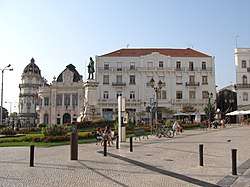
There is a wide variety of accommodation available, ranging from the camping-park or one of the many inexpensive hostels to the charming downtown hotels and international chain hotels.
Parks and gardens
Coimbra has many attractive and pleasant green spaces such as parks, playgrounds, gardens and forests. The most famous park in the city is probably the Botanical Garden of the University of Coimbra, the fifth oldest in the world. The Portugal dos Pequenitos park is an educational theme park built during the Estado Novo. Its buildings are scale copies of Portuguese architectural landmarks and were completed in the 1950s.
The city's green areas also include the Mata Nacional do Choupal, the Mata Nacional de Vale de Canas, Jardim da Sereia (also known as Jardim de Santa Cruz), Penedo da Saudade, Parque Manuel Braga, Parque Verde do Mondego and Choupalinho. Quinta das Lágrimas, a 19th-century palace and estate, which was transformed into a hotel and golf resort, contains also a large park. Also noteworthy is the Paul de Arzila, a natural reserve occupying an area in Coimbra municipality (in Arzila), and in the neighboring municipalities of Condeixa-a-Nova and Montemor-o-Velho.
Not far away from the urban center, close to the city itself, and fully set in the municipality of Coimbra, there are plenty of mountain and river landscapes. These include the river beach of Palheiros do Zorro in the parish of Torres do Mondego. One of Europe's tallest trees, Karri Knight can be found in Valle de Canas of the municipality of Coimbra. It is an Eucalyptus diversicolor of 73 m height and of 5.71 m girth .
International relations
Coimbra is twinned with:[23][24]

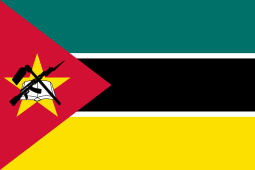




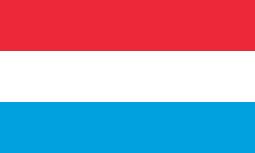



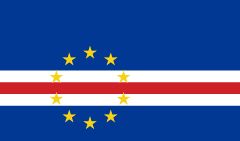









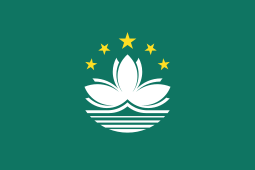


Sport
Coimbra is home to Associação Académica de Coimbra - O.A.F. (known simply as Académica), a professional football autonomous organism of the University of Coimbra students' union Associação Académica de Coimbra, founded in 1872 and having its current statute of autonomous football organization since the 1980s. Académica football team plays in the Portuguese Liga at the Estádio Cidade de Coimbra. Clube de Futebol União de Coimbra, another sports club with tradition in the city, owner of a football team which plays in the Portuguese Second Division, is other important club of Coimbra. Coimbra also has one of the largest multisports clubs in Portugal: the University of Coimbra's students' union Associação Académica de Coimbra, includes sections dedicated to a wide array of sports such as rugby, volleyball, handball, rink hockey, basketball, baseball, tennis, swimming, rowing, among many others.
The Estádio Cidade de Coimbra (30,000 seats), which was a site of 2004 European Football Championship and includes olympic swimming pools (Piscinas Municipais), as well as a multiuse sports facility (Pavilhão Multiusos de Coimbra), located both near the stadium; the Estádio Municipal Sérgio Conceição; and the Estádio Universitário de Coimbra, an extensive sports complex of the university on Mondego's left bank, are the main athletics and sports venues in Coimbra. The Pavilhão Jorge Anjinho sports arena (headquarters of Associação Académica de Coimbra - O.A.F.), Pavilhão dos Olivais, and Pavilhão do C.F. União de Coimbra, are other places where some of the most important indoor sports clashes involving teams of Coimbra are played.
Major sports teams based in Coimbra include:
| Team | Sport | League | Venue |
|---|---|---|---|
| Associação Académica de Coimbra - O.A.F. | Football | Portuguese Liga | Estádio Cidade de Coimbra |
| Associação Académica de Coimbra - Secção de Basquetebol | Basketball | Portuguese Basketball League (LCB) | Pavilhão Multiusos de Coimbra |
| Associação Académica de Coimbra - Secção de Rugby | Rugby | Campeonato Nacional Honra/Super Bock | Estádio Universitário de Coimbra |
| Associação Académica de Coimbra - Secção de Voleibol | Volleyball | Portuguese Volleyball League A1 | Estádio Universitário de Coimbra |
| C.F. União de Coimbra | Football | Portuguese Third Division | Estádio Sérgio Conceição |
| Agrária | Rugby | Campeonato Nacional de Rugby I Divisão | Campo da Escola Agrária |
Notable individuals
The following people were born or died within the municipality of Coimbra:

- Afonso Henriques (c. 1109; Guimarães/Viseu – 6 December 1185; Sé Nova), first Portuguese monarch, who established his residence in the seat of County of Coimbra; he was buried in the Monastery of Santa Cruz;
- Sancho I (11 November 1154; Sé Nova – 26 March 1212; Sé Nova), second king of Portugal, oldest son of Afonso Henriques, responsible for ending Galicia border disputes, and shifting the kingdom's growth to the south, capturing Moorish lands and enlarging Portuguese territory;
- Afonso II (23 April 1185; Sé Nova – 25 March 1223; Sé Nova), third Portuguese monarch, was able to maintain the peace created by the military gains of his father and grandfather, enhancing his relationship with the Catholic Church;
- Sancho II (8 September 1209; Sé Nova - 4 January 1248; Toledo, Spain), the Pious was forced off the throne by an alliance of nobles who, although grateful for their monarch's Reconquista of Moorish lands, did not appreciate his poor administration of the country. His brother Afonso III marched into Portugal, with the support of the Catholic Church, and exiled him to Toledo;
- Afonso III (5 May 1210; Sé Nova – 16 February 1279), unlike his brother, Afonso paid particular attention to the administration of his Kingdom (stylized Kingdom of Portugal and the Algarves), holding the first Portuguese Cortes that reunited the administration, nobility, merchants and landowners, but his taxing of the Church resulted in his ex-communication, likely bringing on his early death, and the ascendancy of his son Denis;
- Elizabeth of Portugal (Holy Queen Isabel), wife of King Denis I. She was buried at the Monastery of Santa Clara-a-Velha.
- Pedro I (19 April 1320; Sé Nova – 18 January 1367; Alcobaça), the Just was credited with a peaceful reign, following the supposed death of his lover Inês de Castro at the hands of his father's men;
- Francisco Álvares ( c. 1465; Sé Nova – c. 1541; Rome), a missionary, explorer and diplomat who traveled to Ethiopia, joining Pêro da Covilhã, before returning to Lisbon in 1526–1527, writing the Verdadeira Informação das Terras do Preste João das Indias ("A True Relation of the Lands of Prester John of the Indies");
- Francisco de Sá de Miranda (28 August 1481; Sé Nova – 17 May 1558; Amares), a Renaissance poet, who studied Greek, Latin and Philosophy at the University (when it was in Lisbon), but who traveled abroad meeting classical writers in Spain and Italy, before being received at the court of John III of Portugal between 1526–1527;
- Pedro Nunes (c. 1502; Alcácer do Sal – 11 August 1578; Sé Nova), a 16th-century mathematician and cosmographer responsible for contributions to navigation during the Age of Discovery;
- Mem de Sá (c. 1500; Sé Nova – 2 March 1572; Salvador, Brazil ), third Governor-General of Brazil, responsible for the pacification of the indigenous population, and the expulsion of the French from Rio de Janeiro, by convincing the Tamoyo Confederation to withdraw their support;
- José de Anchieta (1534-1597), Spanish Jesuit, humanist and writer.
- Joaquim Machado de Castro (19 June 1731 – 17 November 1822; Lisbon), an 18th-century sculptor, notable for his equestrian statue of Joseph I of Portugal, with detailed analysis and diagrams, now occupying the centre of the Praça do Comércio;
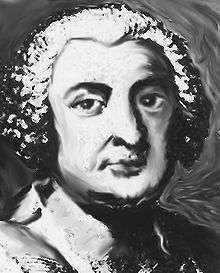
- Carlos Seixas (11 June 1704 – 25 August 1742; Lisbon), prominent composer, musician and teacher;
- João Correia Ayres de Campos (24 August 1818 – 24 March 1885), archaeologist and palaeographer;
- João Maria Correia Ayres de Campos, 1st Count of Ameal (5 February 1847 – 13 July 1920), a politician, art collector and humanist, responsible for assembling one of Portugal's largest and most important private art collections;
- João Ameal, literary pseudonym of Portuguese historian, journalist, politician and novelist João Francisco de Barbosa Azevedo de Sande Ayres de Campos, 3rd Count of Ameal (23 October 1902 – 23 November 1982);
- Mário Simões Dias (2 July 1903 – 8 July 1974; Lourenço Marques, Mozambique), a violinist, musicologist and lecturer, who co-founded the Academia de CoimbraandInstituto de Música, before hosting a classical music program on the national radio, and later in Mozambique;
- Sister Lúcia (28 March 1907; Aljustrel – 13 February 2005; Sé Nova), one of the three visionary children of Our Lady of Fátima, who came to live at the Carmelite Convent of Saint Teresa;
- Miguel Torga (pseudonym of Adolfo Correia da Rocha, 12 August 1907; São Martinho de Anta – 17 January 1995), a medical doctor, later poet, short story essayist, theatre writer and composer of a 16-volume diary, receiving along his career the Montaigne Prize (in 1981), the first Prémio Camões (in 1989) and nominations for the Nobel prize for Literature;
- Álvaro Barreirinhas Cunhal (10 November 1913; Coimbra — 13 June 2005; Lisbon), politician and pro-Soviet leader of the Portuguese Communist Party
- Carlos Paredes (16 February 1925 – 23 July 2004), a virtuoso guitar player and composer, known as the "man of a thousand fingers";
- Carlos Mota Pinto (25 July 1936; Pombal – 7 May 1985), a professor and politician, interim Prime Minister of Portugal between 1978 and 1979, Vice-President in 1983 and President (1984–1985);
- Mário Crespo (13 April 1947 – ), a journalist and reporter;
- Alberto Raposo Pidwell Tavares, known as Al Berto (11 January 1948 – 13 June 1997; Lisbon), a poet;
- Zita Seabra (25 May 1949; Santa Cruz – ), a politician; a former high-profile member of the Portuguese Communist Party, who renounced and criticized communist ideology, before the fall of Berlin Wall, later to join the Social Democratic Party;
- Pedro Passos Coelho (24 July 1964 – ), a politician, leader of the Social Democratic Party, and former Prime Minister of Portugal;
- Sérgio Conceição (15 November 1974 – ), an international footballer, who played for 10 different teams, representing Portugal in one World Cup and European championship;
- Zé Castro (13 January 1983 – ), an international footballer, playing for Deportivo de La Coruña of Spain;
- Zeca Afonso, Portuguese musician.
- Nuno Piloto, Portuguese footballer, captain of the Associação Académica de Coimbra – O.A.F. football team.
- Luis de Matos, Portuguese magician.
- Paulo Furtado, the lead vocalist of the band WrayGunn.
- JP Simões, singer and musician.
- André Sardet, Portuguese singer and musician.
- Filipe Albuquerque, Portuguese race car driver.
- João Neto, Portuguese judo champion.
- Miguel Veloso, Portuguese international footballer.
- Carlos Paião, Portuguese singer and songwriter.
See also
- Hospitais da Universidade de Coimbra
- Queima das Fitas
- Coimbra Group of universities
References
Citations
- "Coimbra". The American Heritage Dictionary of the English Language (5th ed.). Boston: Houghton Mifflin Harcourt. Retrieved 23 July 2019.
- "Coimbra". Merriam-Webster Dictionary. Retrieved 23 July 2019.
- "Coimbra". Lexico UK Dictionary. Oxford University Press. Retrieved 23 July 2019.
- Wells, John C. (21 July 2010). "Portuguese". Retrieved 17 June 2012.
- Instituto Nacional de Estatística
- "Áreas das freguesias, concelhos, distritos e país". Archived from the original on 5 November 2018. Retrieved 5 November 2018.
- "University of Coimbra – Alta and Sofia". unesco.org. UNESCO. Retrieved 13 December 2016.
- David J.J. Evans, Cadogan Guides Portugal (2004), ISBN 9781860111266, p.221
- "Coimbra Castle History". www.castelosemuralhasdomondego.pt. Retrieved 4 April 2020.
- Silva, José Manuel Azevedo (2011), Câmara Municipal (ed.), A criação da freguesia de Santo António dos Olivais: Visão Histórica e Perspectivas Actuais (PDF) (in Portuguese), Santo António dos Olivias (Coimbra), Portugal: Câmara Municipal de Santo António dos Olivais, archived from the original (PDF) on 20 December 2011, retrieved 5 September 2011, p. 2-3
- Santos, Luísa (December 2004), Caracterização Sócio- Económica dos Concelhos Concelho de Coimbra (PDF) (in Portuguese), Coimbra, Portugal: Direcção Geral do Ordenamento do Território e Desenvolvimento Urbano/Direcção de Serviços de Estudos e Planeamento Estratégico/Divisão de Estudos e Planeamento p. 5-13
- Plano Sectoral da Rede Natura 2000 (Zonas de Protecção Especial): Paul de Arzila (PDF) (in Portuguese), Lisbon, Portugal: ICNB Instituto de Conservação da Natureza e da Biodiversidade, archived from the original (PDF) on 27 March 2012
- "Coimbra, Portugal Köppen Climate Classification (Weatherbase)". Weatherbase. Retrieved 19 April 2019.
- "Weather Information for Coimbra (Portuguese Meteorological Institute)".
- "Coimbra (08549) - WMO Weather Station". NOAA. Retrieved 18 April 2019.
- Diário da República. "Law nr. 11-A/2013, page 552 41" (pdf) (in Portuguese). Retrieved 21 July 2014.
- Direcção Municipal de Administração do Território – Câmara Municipal de Coimbra (Coimbra City Hall) Archived 6 June 2007 at the Wayback Machine(in Portuguese)
- Innovnano inaugura nova fábrica em 2011 (in Portuguese), Grupo José de Mello, archived from the original on 22 January 2011
- How can I get from Madrid to Coimbra by train?, Travelinho.com, retrieved 25 September 2018
- "Coimbra Public Transportation Statistics". Global Public Transit Index by Moovit. Retrieved 19 June 2017.

- Conservatório de Música de Coimbra
- "Cidades Geminadas". cm-coimbra.pt (in Portuguese). Coimbra, Portugual: Câmara Municipal de Coimbra. 2014. Retrieved 17 November 2014.
- "Geminações de Cidades e Vilas: Coimbra" (in Portuguese). Associação Nacional de Municípios Portugueses. Retrieved 22 July 2020.
- Association of twinnings and international relations of Aix-en-Provence
- Mairie of Aix-en-Provence – Twinnings and partnerships Archived 13 January 2009 at the Wayback Machine
- "A Message from the Peace Commission: Information on Cambridge's Sister Cities," 15 February 2008. Retrieved 12 October 2008.
- Richard Thompson."Looking to strengthen family ties with 'sister cities'," Boston Globe, 12 October 2008. Retrieved 12 October 2008.
- "Damão, Índia" (in Portuguese). Coimbra, Portugual: Câmara Municipal de Coimbra. 2014. Retrieved 17 November 2014.
- Abbas, Zaffar, ed. (5 January 2016). "Islamabad to get new sister city". Dawn. Karachi, Pakistan: Pakistan Herald Publications.
- "Pesquisa de Legislação Municipal – No 14471" [Research Municipal Legislation – No 14471]. Prefeitura da Cidade de São Paulo [Municipality of the City of São Paulo] (in Portuguese). Archived from the original on 18 October 2011. Retrieved 23 August 2013.
- Lei Municipal de São Paulo 14471 de 2007 WikiSource (in Portuguese)
- Prefeitura.Sp – Descentralized Cooperation Archived 24 December 2008 at the Wayback Machine
- Ayuntamiento de Zaragoza. Hermanamientos y Protocolos de Colaboración Archived 13 October 2007 at the Wayback Machine
Sources
- Deloitte, ed. (22 December 2006), Plano Estratégico de Coimbra: Diagnostic Preliminar (PDF) (in Portuguese), 2, Lisbon, Portugal: Câmara Municipal de Coimbra, archived from the original (PDF) on 23 September 2015
- Câmara Municipal, ed. (2005), Relatório de Gestão: Organização Municipal (PDF) (in Portuguese), Coimbra, Portugal: Câmara Municipal de Coimbra, archived from the original (PDF) on 23 September 2015
Bibliography
External links
| Wikimedia Commons has media related to Coimbra. |
| Wikivoyage has a travel guide for Coimbra. |